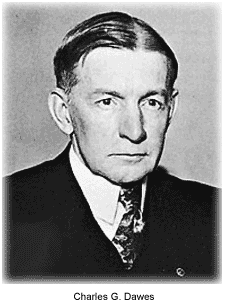In 1921, the international Reparations Commission was established to determine the scope of damages caused by Germany during World War I. An unrealistically high total of $33 billion was forced on the defeated nation, but it managed to make an initial installment payment in September 1921.
However, dire economic conditions in Germany led to default and the imposition of a moratorium by the creditor nations, which hoped that a temporary cessation of payments would allow the German economy to recover so that payments could be resumed. France decided not to wait for the the moratorium to expire and in January 1923, occupied the vital German industrial region in the Ruhr Valley in hope of extracting payment from what they regarded to be a reluctant debtor.
 The United States had not been a party to the Versailles Treaty and, therefore, was not a recipient of reparations. Official government policy during the 1920s held that there was no relationship between Germany’s ability to pay reparations and the Allies’ ability to discharge their war debts to the U.S. However, the deepening economic crisis in Germany and international tensions created by the French invasion induced the Coolidge administration to try to impose some order on the growing chaos.
An international committee was formed with two representatives each from Britain, France, Italy, Belgium, and the United States. The American delegates were financier Charles G. Dawes, who headed the effort, and financier Owen D. Young. A report was issued in April 1924 that called for the following:
The United States had not been a party to the Versailles Treaty and, therefore, was not a recipient of reparations. Official government policy during the 1920s held that there was no relationship between Germany’s ability to pay reparations and the Allies’ ability to discharge their war debts to the U.S. However, the deepening economic crisis in Germany and international tensions created by the French invasion induced the Coolidge administration to try to impose some order on the growing chaos.
An international committee was formed with two representatives each from Britain, France, Italy, Belgium, and the United States. The American delegates were financier Charles G. Dawes, who headed the effort, and financier Owen D. Young. A report was issued in April 1924 that called for the following: